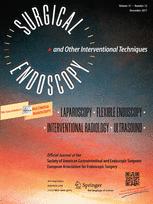Witteman BP, Strijkers R, de Vries E, Toemen L, Conchillo JM, Hameeteman W, Dagnelie PC, Koek GH, Bouvy ND
Surg Endosc. 2012 Nov 26(11):3307-15.
BACKGROUND:
Transoral incisionless fundoplication is a recently introduced endoluminal technique for the treatment of gastroesophageal reflux disease (GERD). The objective of this study was to determine outcomes in chronic GERD patients who were referred for surgical management.
METHODS:
A cohort of 38 patients underwent transoral incisionless fundoplication (TIF) in a tertiary care setting. Pre- and post-procedure assessment included GERD-related quality of life questionnaires, proton pump inhibitor (PPI) usage, 24-h pH measurements, upper gastrointestinal endoscopy, esophageal manometry, and registration of adverse events. Duration of follow-up was 36 months.
RESULTS:
Gastroesophageal valves were constructed of 4 cm (range, 4-6) in length and 220° (range, 180-240) in circumference. One serious adverse event occurred, consisting of intraluminal bleeding at a fastener site. Hiatal hernia was completely reduced in 56 % and esophagitis was cured in 47 % of patients. Postprocedure esophageal acid exposure did not significantly improve (p > 0.05). At 36 (range, 29-41) months follow-up 14 patients (36 %) had undergone revisional laparoscopic fundoplication. Quality of life scores of the remaining cohort showed significant improvement (p < 0.0001) and daily use of antisecretory medication was discontinued by 74 %.
CONCLUSIONS:
Endoluminal fundoplication improved quality of life and reduced the need for PPIs in only a subgroup of patients at 3 years follow-up. The amount of patients requiring additional medication and revisional surgery was high.
Link to PDF file on PMC: Witteman BP, et al; Surg Endosc. 2012 Nov;26(11):3307-15.


